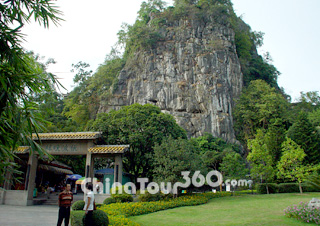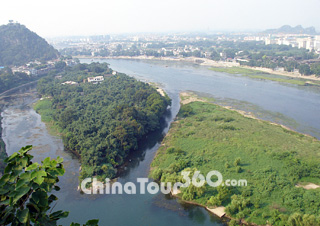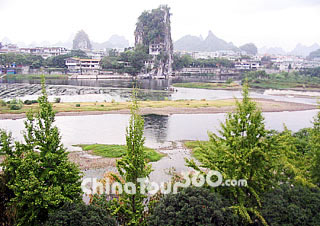 Guilin Fubo Hill
Guilin Fubo Hill Beautiful Scenery around Fubo hill
Beautiful Scenery around Fubo hill Full View of Fubo Hill Park
Full View of Fubo Hill Park
A popular saying goes like this 'The mountains and waters of Guilin are the finest under the heaven'. In addition to the Elephant Trunk Hill, Diecai Hill, there is another hill named as Fubo Hill on the western bank of Li River. Part of the hill is submerged in the river and part of it is standing above ground.
It has an area of about 0.7 hectare with the elevation of 213 meters (699 feet), 62 meters (203 feet) above ground, the length of 120 meters (131 yards) and the width of 60 meters (66 yards). It is named as Fubo, for one thing there was a temple that was once built in memory of the general Fubo in Tang Dynasty (618 - 907), and for another thing, the river is blocked and eddied by the hill, which was believed to have the power of subduing wave. Fubo Hill is famous for its six beauties: hills, water, caves, stones, courts, and cultural relics.
Among the numerous caves on the hill, Pearl-Returning Cave is the most famous. It is the legend that an old fisherman picked up the dragon ball in this cave, which annoyed Dragon King, who then stirred up trouble and brought much disaster to the common people. Later, the fisherman was ordered to give it back for peaceful life, that's the reason why it got its name. The cave was exquisitely wrought by nature. There kept more than 100 pieces of the statues in Tang Dynasty and the stone inscriptions in Song Dynasty (960 - 1276), in which the most valuable are the poems inscribed by Fan Chengda.
The east face of the cave is the open space, while beneath the cave is the bottomless and green Fubo Pool. Beside the river is there a stone pillar hanging down with the upper part thick and the lower end thin. About an inch-long space is connected to the ground, seemingly split up by the sword. It is said to have been made when the General Fubo was testing the sword, thus it was given the name Sword-testing Stone. Those visitors with great curiosity are always inclined to touch the peculiar aperture.
Connecting with the Pearl-Returning Cave lies the Thousand-Buddha Cave. The 3-storeyed cave has an approximate area of 133 square meters (159 square yards). In the upper level, 239 statues of Buddha were engraved in 36 shrines, most of which were created in Later Tang Dynasty (923 - 936). The statues bear genial postures, plain clothing and exquisite carvings. In the cave, the 1.2-meter (3.9 feet) tall self-portrait of Mi Fu can be found inscribed on the stone. What is worth speaking of is Mi Fu is the first who painted the fabulous scenery of Guilin.
Entering the park, you will be saluted by the cast iron clock weighing about 2,500 kilograms (5,512 pounds). In the cloister, there is a big iron boiler about 1,000 kilograms (2,205 pounds)in weight. It is called Thousand-People Boiler because it is said that the boiler is big enough to offer provision for one thousand people at one time. The two huge iron relics were initially placed in Dingyue Temple in Qing Dynasty (1644 - 1911). They were displaced here because Dingyue Temple was ruined in the Anti-Japanese War. Though enduring the erosion in the long course of three hundred years, they were still complete with the inscriptions and ornament clearly visible.
![]() Entrance Fee: CNY 30 (kids under 1.4 me are free)
Entrance Fee: CNY 30 (kids under 1.4 me are free)
![]() Opening Hours: 06:30 - 18:30 (Apr. to Oct.); 07:00 - 18:00 (Nov. to Mar.)
Opening Hours: 06:30 - 18:30 (Apr. to Oct.); 07:00 - 18:00 (Nov. to Mar.)
![]() Best Time to Visit: Apr. to Oct.
Best Time to Visit: Apr. to Oct.
![]() Bus Routes: Take Bus No. 2, 30 or 58 and get off at Fubo Hill stop.
Bus Routes: Take Bus No. 2, 30 or 58 and get off at Fubo Hill stop.








